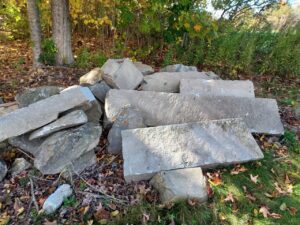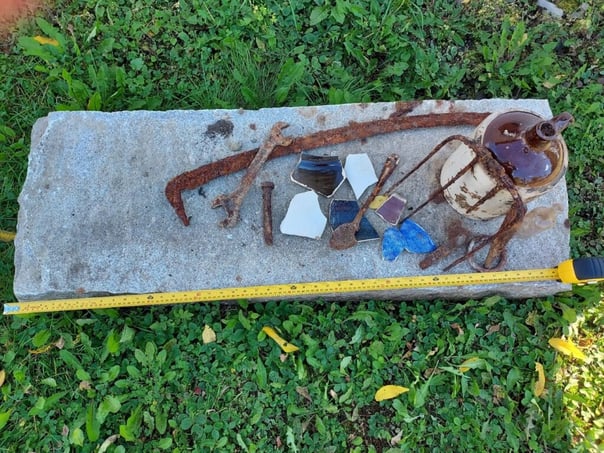 If Our Old House builder, Asa Williams, had recently awakened from his 201-year eternal sleep, he would have seen, with fascinated but utter panic, the thunder of dragons that crawled up my driveway. (I think the blacksmith in Asa would find any fire-breathing dragons very useful ... eventually.) As a patriot and devout Christian, he might have thought that Satan disguised as King George had unleashed his “great red dragon” on him personally.
If Our Old House builder, Asa Williams, had recently awakened from his 201-year eternal sleep, he would have seen, with fascinated but utter panic, the thunder of dragons that crawled up my driveway. (I think the blacksmith in Asa would find any fire-breathing dragons very useful ... eventually.) As a patriot and devout Christian, he might have thought that Satan disguised as King George had unleashed his “great red dragon” on him personally.
Early one Monday a few weeks ago, the first dragon slowly and loudly devoured my old garage, spit out four-to-seven foot granite stones, and reduced two huge maple trees to toothpicks. The second dragon followed and gobbled up the leftovers. The third, bigger dragon arrived and chewed a moat where the old garage was. (Fisherman Husband wants to stock it with fish, but the lack of water in the moat has been a deterrent.)
The fourth and fifth dragons, rotund white beasts with long snouts, rolled in and filled the moat with strange gray stones. The third dragon then returned with its hatchling, who proceeded to stomp wherever it wanted.
The sixth and seventh dragons were stocky and gray, and filled the moat with lots and lots of food for the third beast who gobbled gleefully, spreading it everywhere. I began to think that they were moving in, creating a nest, or building their castle!
*
The dragons, those excavators, cement trucks, and compactors now used instead of manual shovels, were great lawn ornaments for a few days while we waited for things to solidify. Yes, we have demolished the garage my father built about 1950 after he cleared away the remnants of Asa’s forge, bellows, and carriage houses, not to mention the outhouse(s). As custodians of this historic property, we must navigate between centuries to do what is best for the house as well as for ourselves. The “wave method of construction” that appeared in the roof of the garage made it clear that its time had come.
From the look of my house’s cellar and foundation, Asa dug his “moat” essentially the same way but by hand, then levered in huge granite blocks for the foundation instead of today’s concrete. Several granite blocks from the foundations of the forge and carriage houses, some of them more than 79” long, appeared from under several inches of soil and gravel. His “dragons” would have been oxen or horses,[1] probably borrowed, and helpful family members (no mother-in-law jokes here, thank you!).
In the meantime, as the “moat” was dug for the garage’s frost wall and foundation, various items emerged from depths of 2.5’ to 3.5’. Sadly, I was not allowed in the trench, nor could I delay the digging to retrieve items or mark the position of each item as it was found (“puppy-dog eyes” did not work, nor did groveling). One pottery jug, fully intact with cork and sloshing liquid inside, emerged from the trench, along with several glass bottles. Bits of a leather strap appeared. Most of the “finds” that emerged, however, were metal (i.e., no skeletons!): a set of tire chains as well as the tire; a long-handled spoon, the head of a pitchfork (I think I still have the handle for that!), a two-foot-long piece of a drive shaft, scythe blades, and assorted “what was that?!” When I can’t identify something like that, I call The Blind Guy (Husband), tell him to hold his hand out, and ask him. Usually he gets it (one miss was the stuffed deer backside I led him to. He’ll get over that some day.)
I have a slightly better picture of what Asa’s house-building skills were like, as well as some aspects of the daily lives of those who followed him in Our Old House (someone at some time was very fond of “home remedies!”). But I am left with one nagging but unanswerable question: because the frost walls were dug as a deep ditch around a center of untouched earth now covered by a huge pad of concrete, what treasures are left that haven’t been dug up? Maybe that’s where that long-sought stash of gold coins is!
Note
[1] James W. North, The History of Augusta, from the Earliest Settlement to the Present Time (Somersworth, N.H.: New England History Press, 1981). The Ratable Estates table of 1784 shows that Asa worked about 49 acres of land, owned no dwelling house, barn, oxen, or horses, but had two cows and one pig. We believe a “dwelling house” meant a frame house, and that Asa had built a temporary log cabin to live in while building Our Old House, which was first taxed as a “frame house” in 1789.
Share this:

About Jan Doerr
Jan Doerr received a B.A. degree in Sociology/Secondary Education from the University of New Hampshire, and spent a long career in the legal profession while researching her family history. She has recently written and published articles for WBUR.org’s Cognoscenti blog: “Labor of Love: Preserving a 226-Year-Old Family Home and Preparing to Let It Go” and “The Value of Family Heirlooms in a Digital Age.” Jan currently lives with her attorney husband in Augusta, Maine, where she serves two Siamese cats and spends all her retirement money propping up a really old house.View all posts by Jan Doerr →
